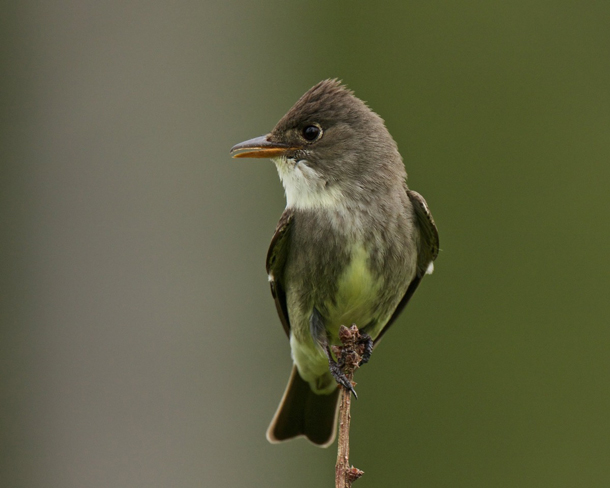BirdNote®: Canada’s Boreal Forests
Air Date: Week of March 27, 2020

The olive-sided flycatcher resides in Canada during the breeding season. (Photo: © Gregg Thompson)
Canada’s vast green boreal forests are home to almost half of North America’s migratory waterfowl and songbirds. As the mining, logging, and fossil fuel industries make increasing inroads, several Dené Indigenous Nations have come to an agreement with the Canadian government to create some of the largest protected areas in Canada’s history. BirdNote®’s Michael Stein has the story.
Transcript
CURWOOD: BirdNote’s Michael Stein reports NATIVE peoples in Canada have been instrumental in protecting one of the most important bird habitats in the world.
BirdNote®
Conserving Canada's Boreal Forests
[Songs and calls of birds that breed in Canada’s boreal forest]
The vast Canadian boreal forest provides breeding habitat for up to three billion of North America’s migratory ducks, geese, and songbirds. Add the young raised over the summer, and there may be as many as five billion birds.

An olive-sided flycatcher sits atop a tree in the boreal forest. (Photo: © Tom Munson)
[Croaking and “conversation” of ravens]
The boreal forest is “one of the largest intact forest and wetland ecosystems remaining on earth.” But the boreal is under increasing pressure from logging, mining, the development of the petroleum, infestations of pine beetles, and climate change. [Call of Boreal Chickadee]
However, Indigenous Nations are protecting boreal forest lands on a sweeping scale. In 2019, the Lutsel K’e Dene First Nation worked with the Canadian government to create one of the biggest protected areas in the country. The Sahtu Dene is planning to conserve an area 12 times the size of Yellowstone.

The boreal forest can seem endless from ground level, but extractive industries are making inroads. (Photo: Keith Williams, Flickr, CC BY-NC-ND 2.0)
And the Sayisi Dene want to preserve over 12 million acres—habitat for millions of nesting land birds and tens of thousands of migrating waterfowl.
The biggest, most ambitious proposals for conserving lands in Canada are coming from Indigenous Nations. And these lands offer hundreds of bird species the best chance to adapt and thrive into the future.
###
Adapted from a script by Todd Peterson
Thanks to Emily Cousins at BorealBirds.org and to Jeff Wells at Audubon for their assistance.
Bird sounds provided by The Macaulay Library of Natural Sounds at the Cornell Lab of Ornithology, Ithaca, New York. Sound track of the boreal forest recorded by G.F. Budney. Calls of Ravens and Sandhill Cranes were recorded by G.A. Keller; Boreal Chickadee by G. Vyn.
Producer: John Kessler
Executive Producer: Sallie Bodie
Editor: Ashley Ahearn
Associate Producer: Ellen Blackstone
Assistant Producer: Mark Bramhill
BirdNote’s theme was composed and played by Nancy Rumbel and John Kessler.
© 2020 BirdNote February 2020
ID# SotB-boreal-01-2011-02-01 SotB-boreal-01b Narrator: Michael Stein
https://www.borealbirds.org/announcements/1500-scientists-worldwide-call...
https://www.birdnote.org/show/conserving-canadas-boreal-forests
CURWOOD: For pictures fly on over to the living on earth website, loe.org.
Links
Living on Earth wants to hear from you!
Living on Earth
62 Calef Highway, Suite 212
Lee, NH 03861
Telephone: 617-287-4121
E-mail: comments@loe.org
Newsletter [Click here]
Donate to Living on Earth!
Living on Earth is an independent media program and relies entirely on contributions from listeners and institutions supporting public service. Please donate now to preserve an independent environmental voice.
NewsletterLiving on Earth offers a weekly delivery of the show's rundown to your mailbox. Sign up for our newsletter today!
 Sailors For The Sea: Be the change you want to sea.
Sailors For The Sea: Be the change you want to sea.
 The Grantham Foundation for the Protection of the Environment: Committed to protecting and improving the health of the global environment.
The Grantham Foundation for the Protection of the Environment: Committed to protecting and improving the health of the global environment.
 Contribute to Living on Earth and receive, as our gift to you, an archival print of one of Mark Seth Lender's extraordinary wildlife photographs. Follow the link to see Mark's current collection of photographs.
Contribute to Living on Earth and receive, as our gift to you, an archival print of one of Mark Seth Lender's extraordinary wildlife photographs. Follow the link to see Mark's current collection of photographs.
 Buy a signed copy of Mark Seth Lender's book Smeagull the Seagull & support Living on Earth
Buy a signed copy of Mark Seth Lender's book Smeagull the Seagull & support Living on Earth

